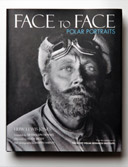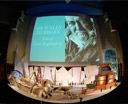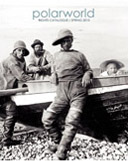 Our ProductsOur Resources |
This website requires the free Flash plugin to be installed.
Polarworld - discover more polar booksThe Arctic Book Review High Latitudes High LatitudesFarley Mowat Reviewed by Jonathan Dore In 1966 Farley Mowat took a trip by floatplane across the Canadian Arctic, attempting to witness a revolution as it was taking place. The former prime minister John Diefenbaker had proclaimed a ‘Northern Vision’ that involved tapping the vast mineral deposits of the Arctic as a way of both increasing the country’s wealth and drawing the Inuit inhabitants of the region into the mainstream of Canadian society, and with remarkable unanimity the administration of his opponent and successor Lester Pearson was now putting the Vision into practice. Mowat, tape recorder in hand, was attempting to interview as many people who lived in the north as he could find, to see what they actually thought about it. In most of the 30-odd settlements at which he stopped, the buildings he encountered told the story of a transition from one era to another. The bright-red metal-roofed bungalows and storehouses of the reigning trinity of what Mowat calls the ‘old empire’ – the Hudson’s Bay Company, the RCMP, and the Church – was everywhere in evidence, yet it was clear that their power was being supplanted by the institutions of the ‘new empire’ – the Canadian government’s Department of Northern Affairs (whose colourful but shoddy ‘cornflake box’ houses for the Inuit dotted every settlement), the mining and drilling companies whose interests the DNA was there primarily to promote, and in the background the shadowy military presence of the Defence Early Warning line installations, with their massive golf-ball radar dishes on the tundra and their fiercely defended no-fly zones. The strongest underlying theme of the book is that this transition, if left unchallenged, would result in the destruction of Inuit culture. There are other, lighter moments, from the descriptions of his resourceful pilot and navigator finding landing spots just before running out of fuel, to his interviews with fishermen telling of their battles with the sea and of an archaeologist friend finding what he interpreted as evidence of ancient northern European settlement along the shoreline of Ungava Bay – a favourite Mowat theme familiar from his earlier books Westviking (1965) and The Farfarers (2000). But it is the plight of the modern Inuit that steadily reveals itself as the central focus of the book. While the HBC had relied on the Inuit pursuing their traditional hunting skills in order to get furs to trade, they had introduced alcohol where it was previously unknown. The Mounties had been generally well respected, but one tragic story Mowat relates – which led to a murder trial that was the origin of his journey – showed the gulf between an inflexible Western conception of law and Inuit conceptions of morality and necessity. It was the Church, however, and it seems particularly the Catholic Church, that had begun the process of centralization, concentrating scattered Inuit populations into a small area that could not sustain them by hunting, and in the process making them dependent on welfare handouts and increasing the risks of disease. (Ever since the counter-reformation, of course, the Catholic Church has used the size and opulence of its cathedrals as symbols of power with which to impress indigenous populations. Seldom can the strategy have been as ineffective as in the Arctic, where grotesquely outsize churches of mud-mortared rock, exposed to relentless cold on the outside and condensation inside, have slumped back into the landscape with ignominious speed). The driving force of the new empire, the Department of Northern Affairs, was building on this centralizing legacy by insisting that Inuit settle together so that they could be more effectively ‘administered’. Families were threatened with the deportation of their children to schools in the south if they did not agree to settle and have them schooled in situ. Yet even a schooling in another settlement in the north might mean long exile from families, with some schools insisting children stay on at ‘hostels’ over the summer (easily enforced when whites controlled access to the air transport necessary for long distance travel in the north) in a crudely obvious attempt to break the links of language and culture between one generation and the next. Without the crucial skills of hunting, sewing, cooking, skin preparation, and snow-house building that would allow them to survive independently, this deracinated generation would become docile, English-speaking, house-dwelling wage earners in the burgeoning, resource-industry driven money economy of the new north. One of the startling themes that Mowat brings out is the casualness with which promises of jobs and money were made and then broken. The only truly steady wage-earning jobs in the north were those of administration itself, and the technical jobs associated with the resource industries – all effectively reserved for whites. With no hope of this kind of employment, the Inuit were left with inherently unsteady work such as driving bulldozers and unloading ships. It didn’t seem to occur to the administrators that once construction projects were completed, most of these casual jobs would cease to exist. Without the knowledge or resources to return to hunting, nothing but enforced welfare dependency then beckoned for the Inuit, with its seemingly inevitable downward spiral of depression and alcohol abuse. In most of the places he visited Mowat found wellsprings of dissent. His interpreter on the trip, Peter Murdoch, was a rebel ex-DNA employee who used the opportunity to organize resistance in the places they visited. Many government and HBC employees they met – virtually all, it seems, hailing from Newfoundland – were sympathetic, and many had begun experimenting with cooperatives, marketing mostly furs and artwork, as a way in which the Inuit could enter the money economy while still retaining control of their lives and maintaining the ‘share and share alike’ ethos of traditional Inuit culture. The happiest places, where the travellers received the warmest welcome, were the few settlements where the Inuit had maintained their independence and way of life. Where southern influence predominated, a feeling of fatalistic acquiescence had settled over the Inuit population. Only the young, the targets of this cultural scorched-earth policy, retained a sense of anger at what was being done to them. The central mystery of the book is why it has taken 35 years for Mowat to actually present the material he painstakingly collected. The trip was financed by his publishers, McClelland and Stewart, for the purpose of researching a book – the Arctic volume of a series about different Canadian regions – that appeared as Canada: North in 1967. While the geographical focus of that series precluded much of the material presented here, there is no obvious reason why another book focusing on what clearly most interested Mowat about his trip – the plight of the Inuit – could not have been published shortly after, when it could perhaps have had an impact on government policy. Many of his Inuit interviewees were clearly expecting something of the sort to happen, since they used the interviews as a platform to address southern Canadians about the iniquities their government was perpetrating in their name. Margaret Atwood’s foreword says – and the back cover blurb repeats – that the book Mowat originally envisaged ‘was not the one that appeared at the time, for the reasons Mowat describes’. Possibly Atwood had access to some earlier, fuller draft, for despite assiduous looking I could not find even the briefest explanation from the author on why he had let his interlocutors’ words hang in mid-air for more than three decades, or any trace of unease or sorrow that he had done so. In this context, the 1996 exposé by John Goddard of certain factual inaccuracies, or more strictly exaggerations, in some of Mowat’s early books about the North come to mind. Should we also treat this material with a certain scepticism? A benefit of 35 years’-worth of hindsight could have been to put these distressing stories of hardship and cultural conflict in a wider context by showing how the situation has developed in the intervening years. This is especially so in Mowat’s case since his 1966 trip was just one of many to the Arctic that he made between the 1940s and the 1990s. The unusual extent of his acquaintance with the North could have given great subtlety and depth to his examination of where these experiences fitted into a wider picture. Except for a few specific examples, however, in which the current fate of certain settlements, for better or worse, is briefly described, this opportunity is sadly not taken. While many might have said that Mowat’s own writings have been a factor in the long movement for greater political self-determination by Canada’s First Nations, High Latitudes offers no analysis of the struggle that got the Inuit from the place he leaves them in 1966 to the creation of the new territory of Nunavut in 1999; of the extent to which Nunavut is or is not fulfilling the hopes of those past interviewees; or of what practical steps have been taken to try to reverse the cultural alienation suffered by the young generation he encountered then. But perhaps we are looking in the wrong place. Passion – especially passionate indignation – not analysis, is the driving force of Mowat’s writing, and a passionate account of injustice is what he presents. But for a wider context, reader ... well, you’re on your own. |
|
||
follow us  | join us | join us  | home | contact | home | contact
|
||||
|
© Copyright Polarworld Ltd
SiteWizard.co.uk Web Site Design Company |
||||


